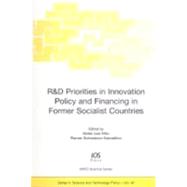R and D Priorities in Innovation Policy and Financing in Former Socialist Countries
, by Leal Filho, Walter; NATO Advanced Research Workshop on R & D Priorities in Innovation Policy and Financing in Former Socialist Countries (2004 : Blagoevgrad, Bulgaria); Gramatikov, Plamen Svetoslavov- ISBN: 9781586034788 | 1586034782
- Cover: Hardcover
- Copyright: 2/26/2005
While the nations of Central and Eastern Europe transform their economies from a planning and centralized control towards free market systems, they face the need to formulate their R&D priorities and to change their systems of innovation. The problems of restructuring the R&D and innovation systems of the post-socialist countries have so far been treated as marginal within the overall institutional transformations that are taking place in these nations. In other words, innovation and in particular, support mechanisms to innovation have not been a priority in the past. It is a fact that progress in science, technology, and innovation-related policy-making in the transitional countries has been rather modest and has largely failed to keep pace with other areas of social, political, and economic change. Most of the transitional countries lack the institutional capability for sophisticated policy making on R&D, for technology transfer and innovation and for building consensus among experts, corporate decision makers and members of the research community on R&D and innovation policy issues. There is relatively little recognition of the growing importance of knowledge and continuous life-long learning as the basis for economic success in the 21st Century. One of the tools that may help the modernization of R&D and innovation-related policy-making is the training and retraining of policy-makers and knowledge and innovative managers. Moreover, it is important to equip them with the tools to take advantage of the various financing possibilities available for innovation. This book attempts to explore the different dimensions of innovation and how it relates to R&D development and financing in a set of eastern and central European countries. The matter of funding for innovation (especially, but not only EU support) is both sensitive and important, and is considered in this book.







